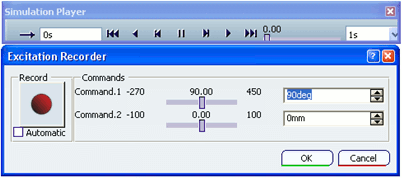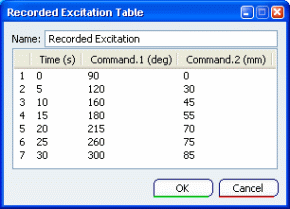If the Excitation Recorder dialog box is not open,
double-click Recorded Excitations in the specification tree.
Both the Excitation Recorder dialog box and the Simulation Player appear.

If an incident is detected, a message appears. You can access the immersive Incident Diagnosis dialog box by clicking  to analyze and solve the problem. See Diagnosing Computation Incidents. to analyze and solve the problem. See Diagnosing Computation Incidents.
Select either the automatic or the manual mode.
- Select the Automatic check box in the Excitation Recorder dialog box to record values automatically. By default, the Automatic check box is cleared.
- Clear the Automatic check box in the Excitation Recorder dialog box to manually record the command values.
To modify and record the values of a recorded excitation: - In manual mode, use the sliders or spinners in the Excitation Recorder dialog box, and click
 . .
- In automatic mode, use the sliders or spinners in the Excitation Recorder dialog box in sequence. Any new command value is automatically recorded.
As each command value is recorded, the Simulation Player goes to the next time step. The time step increment depends on the Time step value you defined in the scenario parameters. Any probes that are included in the kinematics scenario are dynamically updated. To learn more about how the time increments are interpolated during a simulation, see Interpolation of Time Increments.
Repeat Step 3 to complete the recorded excitation.
At any time, you can use the Simulation Player to animate the command values you have recorded. To learn more about the simulation player, see the Assembly Path Definition User's guide: About the Simulation Player.
Click OK. The mechanism returns to its nominal position. If you are in the context of a kinematics scenario creation, the End time value in the scenario parameters is modified so that it equals the last recorded time. To manually modify the values of a recorded excitation: - Right-click the recorded excitation in the specification tree, and select Edit Table.
The Recorded Excitation Table dialog box appears.

- To modify a time value or a command value, click it, and enter the desired value.
- To add a row, right-click a line and select Add Row.
The new empty row is inserted after the line you selected.
- To remove a line or a selection of lines, right-click it, and select Delete Rows.
- To remove all the lines of the table, right-click, and select Delete All Rows.
To export a recorded excitation to an Excel file, right-click a recorded excitation under the scenario in the specification tree, and select Export. See Exporting a Recorded Excitation.
|